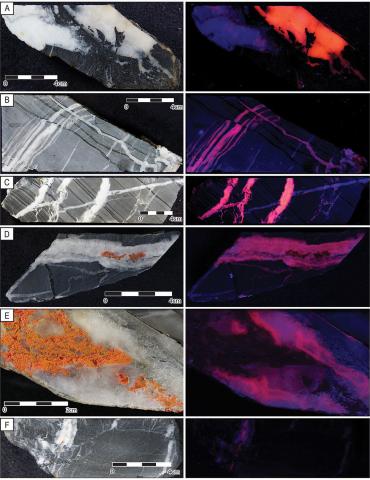Researchers: Andrew Steiner, Marg Amini, Dominique Weis, Ken Hickey, Corey Wall
What question or problem are you trying to address?
Common to many rocks, veins are geological features that form when fluids precipitate minerals into open fractures. The timing of veins provides critical temporal constraints on the timing of deformation and fluid flow. Carbonates are some of the most common vein-filling minerals, and they contain minute concentrations (<5 ppm) of uranium.
Recent improvements in laser ablation (LA) ICP-MS instrument sensitivity allow us to measure this uranium and the radiogenic lead isotopes that form from the radioactive decay of different uranium isotopes. The ratios of these isotopes can be used to determine the formation age of the carbonate. The tendency of carbonate to dissolve and precipitate readily means that uranium and lead distribution throughout samples are erratic, and some parts of the samples have had uranium added after their formation, obscuring the actual age of the vein. We are developing methods to work around these heterogeneities to date hydrothermal carbonate veins.
Why is this research important?

Dating hydrothermal carbonate veins allows us to tell when important geological events happened in the past. For example, Parrish et al. (2018) used U-Pb dating of carbonate to constrain the timing of an ancient continental collision, and Nuriel et al. (2017) used the method to date strike-slip movement between the African and Arabian tectonic plates. As well as tectonic events, U-Pb carbonate geochronology can indicate the timing of fluid flow events.
Currently, we are dating carbonate veins from Carlin-type gold deposits that will tell us the timing of the hydrothermal fluid flow that deposited the gold (Fig. 1). These economically significant deposits have very few dateable ore minerals and are consequently notoriously difficult to date. An improved understanding of when they formed relative to other geological events will provide an improved understanding of the geological criteria required to form the deposits, which is a critical consideration when exploring for them.
How will you accomplish your research?
First, we ensure that the vein comprises the carbonate generation of interest. For the Carlin-type deposit samples, we used UV-fluorescence to distinguish ore-stage veins from other vein generations. Then we create a laser raster image over a ~10 mm2 area of the sample using a quadrupole ICP-MS. Figure 1 shows us where the high uranium parts of the vein are, and we can obtain a preliminary age using a bulk image-based dating method developed by Drost et al. (2018). We then target the areas of the vein that look like they have a high uranium content and simple U-Pb systematics and analyze ~100 spots in these areas using the Nu Attom high-resolution ICP-MS. Spots with high uncertainty or that have had uranium added relative to the image-based date are disregarded. The data is reduced, and a date for the sample is calculated from these remaining spots using a Terra-Wasserburg Concordia diagram.
What do you hope to find or what are your main findings?
Our preliminary results show that ore-stage veins and alteration minerals in a Carlin-type gold deposit in the Yukon formed in at least three discrete fluid flow events over ~40 Mya. Until now, most researchers have assumed that Carlin-type deposits formed in one single fluid flow event. However, Carlin-type deposits occur in actively deforming geological environments, and the fluids dissolve the limestone host rocks, creating large permeable flow paths. Thus, it is perhaps not unsurprising that hydrothermal fluids exploited the same flow paths repeatedly. It is still unclear whether the gold deposition occurred in all of the fluid flow events or just in one and whether the hydrothermal events were of equal magnitude.
References
Drost, K., Chew, D., Petrus, J.A., Scholze, F., Woodhead, J.D., Schneider, J.W. and Harper, D.A. 2018. An image mapping approach to U‐Pb LA‐ICP‐MS carbonate dating and applications to direct dating of carbonate sedimentation. Geochemistry, Geophysics, Geosystems, 19: 4631–4648.
Nuriel, P., Weinberger, R., Kylander-Clark, A.R.C., Hacker, B.R. and Craddock, J.P 2017
The onset of the Dead Sea transform based on calcite age-strain analyses. Geology, 45: 587–590.
Parrish, R.R., Parrish, C.M. and Lasalle, S. 2018. Vein calcite dating reveals Pyrenean orogen as cause of Paleogene deformation in southern England. Geochemistry, Geophysics, Geosystems, 175: 425–442.